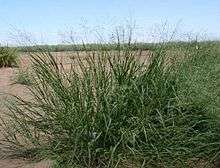Panicum coloratum
Panicum coloratum is a species of grass known by the common names kleingrass, blue panicgrass[1] (USA),[2][3] white buffalograss (southern Africa);[1] Bambatsi panic, makarikari grass,[2] and coolah grass (Australia).[1] It is native to Africa,[3] and it has been introduced elsewhere, such as the United States and Australia, and bred into many cultivars.[1]
| Panicum coloratum | |
|---|---|
 | |
| Scientific classification | |
| Kingdom: | Plantae |
| Clade: | Tracheophytes |
| Clade: | Angiosperms |
| Clade: | Monocots |
| Clade: | Commelinids |
| Order: | Poales |
| Family: | Poaceae |
| Subfamily: | Panicoideae |
| Genus: | Panicum |
| Species: | P. coloratum |
| Binomial name | |
| Panicum coloratum | |
This plant is variable in appearance.[1] In general, is a perennial bunchgrass which usually has rhizomes. The firm, usually erect stems grow up to 1.4 meters tall. The leaf blades are 10 to 30 centimeters long.[4] They are green to a waxy blue-green color.[1] The panicles are variable in length.[4] The spikelets are green and purple.[1]
This grass is used as a pasture grass and to make hay.[1] It produces a large amount of forage for animals.[3] It is drought-tolerant and does well in hot climates.[5] This C4 plant can grow on saline soils[6] and requires an amount of sodium for effective photosynthesis.[7][8] Different cultivars have varying tolerances of sodium.[9] While it makes a good graze for animals, the grass has occasionally been associated with liver damage and photosensitivity in young ruminants and horses.[3][10][11] This photosensitivity can lead to sunburn, which causes swelling of the head and ears of the animal, a condition commonly called "swellhead".[12]
Cultivars include 'Pollock', 'Bambatsi',[2] 'Bushman Mine', 'Verde',[1] and 'Kabulabula'.[8]
References
- Panicum coloratum. Tropical Forages.
- Bambatsi Panic. Government of Western Australia Department of Agriculture and Food.
- Panicum coloratum. USDA NRCS Plant Fact Sheet.
- Panicum coloratum. Archived 2012-12-15 at Archive.today Grass Manual Treatment.
- Blake, C. Kleingrass gains ground in desert ag. Western Farm Press September 3, 2009.
- Behling, A. Kleingrass catches on. Archived 2010-11-25 at the Wayback Machine Hay and Forage Grower February 1, 2001.
- Murata, S. and J. Sekiya. (1992). Effects of sodium on photosynthesis in Panicum coloratum. Plant Cell Physiol 33(8) 1239-42.
- Matoh, T. and S. Murata. (1990). Sodium stimulates growth of Panicum coloratum through enhanced photosynthesis. Plant Physiol 92 1169-73.
- Taleisnik, E., et al. (1998). Salinity effects on the early development stages of Panicum coloratum: Cultivar differences. Grass and Forage Science 53(3) 270-78.
- Hepatotoxic Plants. Merck Veterinary Manual.
- Bridges, C. H., et al. (1987). Kleingrass (Panicum coloratum L.) poisoning in sheep. Vet Pathol 24(6) 525-31.
- Sheep, goat producers should watch for kleingrass problems. Archived 2015-08-28 at the Wayback Machine Livestock Weekly
https://www.ncbi.nlm.nih.gov/m/pubmed/3192474/ Kleingrass can cause liver failure in equines. It’s not a safe source of nutrition.